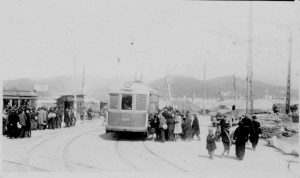Documenting Hiroshima of 1946: In January, restoration of streetcar tracks underway
Jan. 15, 2025
by Minami Yamashita, Staff Writer
In January 1946, restoration was underway of streetcar tracks operated by the Hiroshima Electric Railway Co. (Hiroden). The lines were being upgraded from a single-track to a double-track to enable streetcars to pass by each other. Norman Currell, 21 at the time, was a reserve in the Royal Australian Navy. Mr. Currell took a photograph of the intersection in the area of Kamiya-cho (in Hiroshima’s present-day Naka Ward) between the end of 1945 and early 1946. The photo shows many passengers boarding a streetcar.
Prior to that photo, the Chugoku Shimbun dated December 17, 1945, reported that the times of streetcar operations in the city had been extended, because Hiroden had been able to arrange streetcars and hire the necessary employees. The earliest streetcars departed from the Kamiya-cho stop at 5:48 a.m. bound for Ujina and Hiroshima Station. The last streetcar left Kamiya-cho bound for the Hiroshima Dentetsu-mae stop at 8:24 p.m.
The streetcars in the city had resumed operations between the Koi and Nishitenma-cho stops three days after the atomic bombing. The other lines were then restored step by step. However, there were cases of A-bombed cars still remaining on tracks, with some rail switches in Kamiya-cho not always functioning. In addition, since the streetcars could not pass by each other on a single-track, they would stop and return in the direction from which they had come at Kamiya-cho to reduce service intervals. Adoption of multiple tracks was eagerly awaited.
Meanwhile, Hiroden’s Yokogawa line was partially reopened on December 26, 1945, between the Tokaichi stop and the track switching point in front of Yokogawa Bridge. However, Yokogawa Bridge had been washed away in the Makurazaki Typhoon, which had struck Hiroshima in September that year. The line was finally connected to the terminal in Yokogawa three years after the bombing.
The Girls’ School of Hiroshima Electric Railway, which opened in 1943 and supported streetcar operations during the war, was closed in conjunction with the conclusion of the war. Haruno Horimoto, who died in 2012 at the age of 82, experienced the bombing when she was 16 and a second-year student at the school. Ms. Horimoto served as a conductor on the “first streetcar” that operated after the bombing. She was personally “in a terrible state both physically and psychologically” because the whereabouts of her mother were unknown and she herself was suffering from symptoms of diarrhea, as described in the publication Densha-nai Hibakusha no Shogen (in English, ‘Testimonies of survivors experiencing A-bombing in streetcars’), published in 1985. Ms. Horimoto left Hiroshima after being orphaned by the bombing and losing her school.
(Originally published on January 15, 2025)
In January 1946, restoration was underway of streetcar tracks operated by the Hiroshima Electric Railway Co. (Hiroden). The lines were being upgraded from a single-track to a double-track to enable streetcars to pass by each other. Norman Currell, 21 at the time, was a reserve in the Royal Australian Navy. Mr. Currell took a photograph of the intersection in the area of Kamiya-cho (in Hiroshima’s present-day Naka Ward) between the end of 1945 and early 1946. The photo shows many passengers boarding a streetcar.
Prior to that photo, the Chugoku Shimbun dated December 17, 1945, reported that the times of streetcar operations in the city had been extended, because Hiroden had been able to arrange streetcars and hire the necessary employees. The earliest streetcars departed from the Kamiya-cho stop at 5:48 a.m. bound for Ujina and Hiroshima Station. The last streetcar left Kamiya-cho bound for the Hiroshima Dentetsu-mae stop at 8:24 p.m.
The streetcars in the city had resumed operations between the Koi and Nishitenma-cho stops three days after the atomic bombing. The other lines were then restored step by step. However, there were cases of A-bombed cars still remaining on tracks, with some rail switches in Kamiya-cho not always functioning. In addition, since the streetcars could not pass by each other on a single-track, they would stop and return in the direction from which they had come at Kamiya-cho to reduce service intervals. Adoption of multiple tracks was eagerly awaited.
Meanwhile, Hiroden’s Yokogawa line was partially reopened on December 26, 1945, between the Tokaichi stop and the track switching point in front of Yokogawa Bridge. However, Yokogawa Bridge had been washed away in the Makurazaki Typhoon, which had struck Hiroshima in September that year. The line was finally connected to the terminal in Yokogawa three years after the bombing.
The Girls’ School of Hiroshima Electric Railway, which opened in 1943 and supported streetcar operations during the war, was closed in conjunction with the conclusion of the war. Haruno Horimoto, who died in 2012 at the age of 82, experienced the bombing when she was 16 and a second-year student at the school. Ms. Horimoto served as a conductor on the “first streetcar” that operated after the bombing. She was personally “in a terrible state both physically and psychologically” because the whereabouts of her mother were unknown and she herself was suffering from symptoms of diarrhea, as described in the publication Densha-nai Hibakusha no Shogen (in English, ‘Testimonies of survivors experiencing A-bombing in streetcars’), published in 1985. Ms. Horimoto left Hiroshima after being orphaned by the bombing and losing her school.
(Originally published on January 15, 2025)








